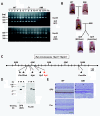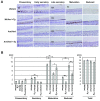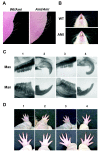Novel genetic linkage of rat Sp6 mutation to Amelogenesis imperfecta
- PMID: 22676574
- PMCID: PMC3464675
- DOI: 10.1186/1750-1172-7-34
Novel genetic linkage of rat Sp6 mutation to Amelogenesis imperfecta
Abstract
Background: Amelogenesis imperfecta (AI) is an inherited disorder characterized by abnormal formation of tooth enamel. Although several genes responsible for AI have been reported, not all causative genes for human AI have been identified to date. AMI rat has been reported as an autosomal recessive mutant with hypoplastic AI isolated from a colony of stroke-prone spontaneously hypertensive rat strain, but the causative gene has not yet been clarified. Through a genetic screen, we identified the causative gene of autosomal recessive AI in AMI and analyzed its role in amelogenesis.
Methods: cDNA sequencing of possible AI-candidate genes so far identified using total RNA of day 6 AMI rat molars identified a novel responsible mutation in specificity protein 6 (Sp6). Genetic linkage analysis was performed between Sp6 and AI phenotype in AMI. To understand a role of SP6 in AI, we generated the transgenic rats harboring Sp6 transgene in AMI (Ami/Ami + Tg). Histological analyses were performed using the thin sections of control rats, AMI, and Ami/Ami + Tg incisors in maxillae, respectively.
Results: We found the novel genetic linkage between a 2-bp insertional mutation of Sp6 gene and the AI phenotype in AMI rats. The position of mutation was located in the coding region of Sp6, which caused frameshift mutation and disruption of the third zinc finger domain of SP6 with 11 cryptic amino acid residues and a stop codon. Transfection studies showed that the mutant protein can be translated and localized in the nucleus in the same manner as the wild-type SP6 protein. When we introduced the CMV promoter-driven wild-type Sp6 transgene into AMI rats, the SP6 protein was ectopically expressed in the maturation stage of ameloblasts associated with the extended maturation stage and the shortened reduced stage without any other phenotypical changes.
Conclusion: We propose the addition of Sp6 mutation as a new molecular diagnostic criterion for the autosomal recessive AI patients. Our findings expand the spectrum of genetic causes of autosomal recessive AI and sheds light on the molecular diagnosis for the classification of AI. Furthermore, tight regulation of the temporospatial expression of SP6 may have critical roles in completing amelogenesis.
Figures




Similar articles
-
A missense variant in specificity protein 6 (SP6) is associated with amelogenesis imperfecta.Hum Mol Genet. 2020 Jun 3;29(9):1417-1425. doi: 10.1093/hmg/ddaa041. Hum Mol Genet. 2020. PMID: 32167558 Free PMC article.
-
Isolation and characterization of dental epithelial cells derived from amelogenesis imperfecta rat.Oral Dis. 2016 Mar;22(2):132-9. doi: 10.1111/odi.12396. Epub 2016 Jan 11. Oral Dis. 2016. PMID: 26582753
-
A Novel De Novo SP6 Mutation Causes Severe Hypoplastic Amelogenesis Imperfecta.Genes (Basel). 2021 Feb 26;12(3):346. doi: 10.3390/genes12030346. Genes (Basel). 2021. PMID: 33652941 Free PMC article.
-
Molecular biology of hereditary enamel defects.Ciba Found Symp. 1997;205:200-5; discussion 205-9. doi: 10.1002/9780470515303.ch14. Ciba Found Symp. 1997. PMID: 9189626 Review.
-
Enamelin and autosomal-dominant amelogenesis imperfecta.Crit Rev Oral Biol Med. 2003;14(6):387-98. doi: 10.1177/154411130301400602. Crit Rev Oral Biol Med. 2003. PMID: 14656895 Review.
Cited by
-
Mesenchymal stem cells for regenerative medicine in central nervous system.Front Neurosci. 2022 Dec 13;16:1068114. doi: 10.3389/fnins.2022.1068114. eCollection 2022. Front Neurosci. 2022. PMID: 36583105 Free PMC article. Review.
-
A missense variant in specificity protein 6 (SP6) is associated with amelogenesis imperfecta.Hum Mol Genet. 2020 Jun 3;29(9):1417-1425. doi: 10.1093/hmg/ddaa041. Hum Mol Genet. 2020. PMID: 32167558 Free PMC article.
-
MAST4 regulates stem cell maintenance with DLX3 for epithelial development and amelogenesis.Exp Mol Med. 2024 Jul;56(7):1606-1619. doi: 10.1038/s12276-024-01264-5. Epub 2024 Jul 1. Exp Mol Med. 2024. PMID: 38945953 Free PMC article.
-
Transplantation of Mesenchymal Stromal Cells in Patients With Amyotrophic Lateral Sclerosis: Results of Phase I/IIa Clinical Trial.Cell Transplant. 2017 Apr 13;26(4):647-658. doi: 10.3727/096368916X693716. Epub 2016 Nov 7. Cell Transplant. 2017. PMID: 27938483 Free PMC article. Clinical Trial.
-
Wnt/β-Catenin Regulates the Activity of Epiprofin/Sp6, SHH, FGF, and BMP to Coordinate the Stages of Odontogenesis.Front Cell Dev Biol. 2016 Mar 30;4:25. doi: 10.3389/fcell.2016.00025. eCollection 2016. Front Cell Dev Biol. 2016. PMID: 27066482 Free PMC article.
References
-
- Witkop CJ Jr. Amelogenesis imperfecta, dentinogenesis imperfecta and dentin dysplasia revisited: problems in classification. J Oral Pathol. 1988;17:547–553. - PubMed
-
- Cho SH, Seymen F, Lee KE, Lee SK, Kweon YS, Kim KJ, Jung SE, Song SJ, Yildirim M, Bayram M, Tuna EB, Gencay K, Kim JW. Novel FAM20A mutations in hypoplastic amelogenesis imperfecta. Hum Mutat. 2011;33:91–94. - PubMed
-
- O'Sullivan J, Bitu CC, Daly SB, Urquhart JE, Barron MJ, Bhaskar SS, Martelli-Junior H, dos Santos Neto PE, Mansilla MA, Murray JC, Coletta RD, Black GC, Dixon MJ. Whole-Exome sequencing identifies FAM20A mutations as a cause of amelogenesis imperfecta and gingival hyperplasia syndrome. Am J Hum Genet. 2011;88:616–620. - PMC - PubMed
Publication types
MeSH terms
Substances
LinkOut - more resources
Full Text Sources
Molecular Biology Databases
Miscellaneous

